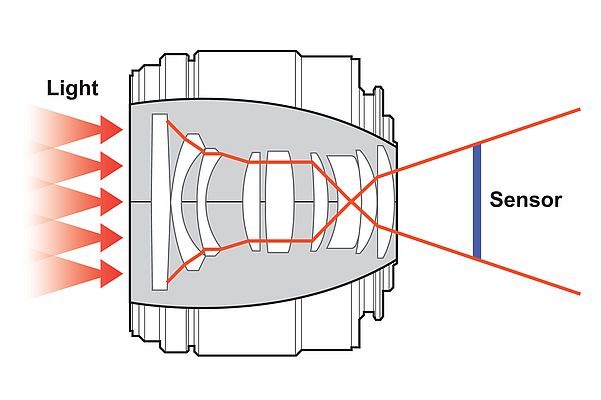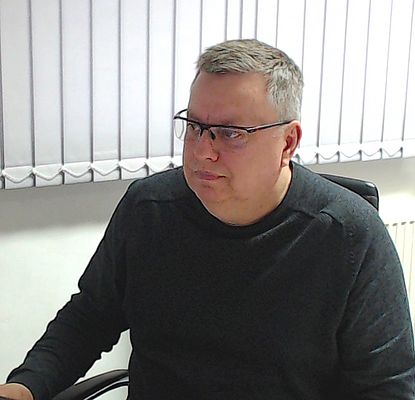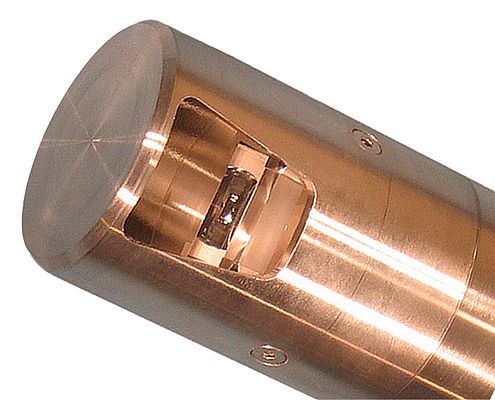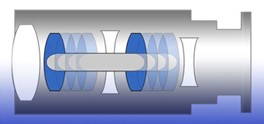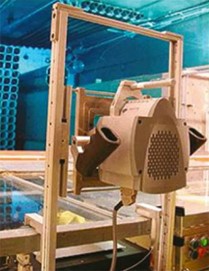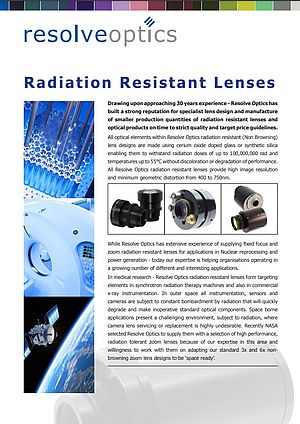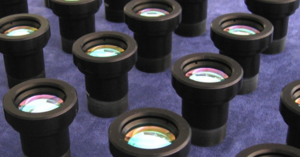Off-the-shelf versus custom design lenses? Do smaller optical systems mean lower performance? Athermal lenses: the solution for higher temperature applications? Today's industrial applications can seriously put optical design to the test. But finding the best compromise solution is never impossible. Mark Pontin, Managing Director at Resolve Optics, explains how you can get superior optical performance while meeting demanding challenges.
IEN Europe: Resolve Optics is highly experienced at producing machine vision lenses. What are the advantages of your application optimized lenses versus standard off-the-shelf lenses?
M. Pontin: We would never suggest a custom design over an off the shelf (OTS) solution if a suitable OTS lens exists then this is the direction we would point the customer. However, applications where OTS lenses deliver at best a compromise solution are a Resolve Optics specialty. We are highly experienced at producing application optimized machine vision lenses that provide wide fields of view with little or no distortion, optical designs and coatings that are balanced to give best performance at a desired wavelength or waveband and compact lens designs where your target vision application is space limited. We have particular expertise in developing, under OEM contract, fixed and zoom lenses for machine vision applications including parts recognition, precise component placement, automated alignment and placement as well as automated inspection of manufactured components.
Apart from superior optical performance there are other advantages to commissioning a custom design with Resolve Optics such as lens exclusivity to give you a competitive advantage. You will also have security of supply eliminating the risk of a vital lens being discontinued which can happen without notice with OTS lenses.
IEN Europe: Markets are demanding ever-smaller optical systems to make measurements and capture images. Do you think that it is possible to ensure the same performance with a smaller product?
M. Pontin: The size of any lens is subject to the laws of physics. In order to ensure the same performance with smaller lenses you will also need for development of smaller and smaller matched sensors. For example, if you think of the lenses on your mobile phone. Reduction of the camera lens size here has been achieved through the use of very small and very thin molded aspheric elements coupled with some very clever sensor electronics. To use molded lens elements in a product design typically requires a commitment to order in the region of 5,000 lens sets per year to get costs down to a commercially viable level.
For lower volume applications, S-mount or M12 mount lenses are about a small as things get before small batch assembly becomes time consuming and expensive. When you have a space limited application – I would always recommend that you talk to Resolve Optics ahead of the selecting your camera or sensor if possible. This will enable us to advise how much room is likely to be required for the lens which will then give you a better idea of what camera or sensor you can fit within the space envelope.
IEN Europe: Resolve Optics’ radiation hard lenses were used recently in satellite-based video cameras. How important is the space market for your business? Do you see a growth in demand there?
M. Pontin: Over the last 10 -15 years we have been honored to be repeatedly selected by leading space agencies and commercial satellite companies to develop specialist optical systems for them that can withstand the rigors of launch and the hostile environment of space. However, to be honest, lenses for space applications will never make us a fortune as the market is just too small. Of course, as with any new lens design you hope the demand will eventually grow but Resolve Optics does not see this as the main reason for designing and manufacturing lenses for space. We like the challenge of designing lenses that can operate reliably in space.
To make technology work in space is not straight forward, with both mechanical and environmental challenges, such as extreme temperature changes and radiation that can damage electronics and hardware. Space is also very mass sensitive because each gram costs money to launch. As a consequence, we were approached recently by a satellite company that needed a specialist provider who could custom design and manufacture cameras to meet both the unique constraints of spaceflight hardware and the environmental challenges of operating in space for several years. Commercially available camera lenses were not suitable for this application because the glass would increasingly suffer from radiation ‘browning’ – meaning that image quality would gradually deteriorate over the life of the satellite. We were selected to assist with this project because of our expertise in custom designing low mass, high performance lenses using radiation resistant glass that could meet the harsh demands of the space environment.
IEN Europe: A large number of industrial applications require measurements at higher temperatures, how does this affect optical systems? What experience does Resolve have in designing and producing high temperature optical systems?
M. Pontin: Designing optical systems for industrial applications running at elevated temperatures can be challenging. When an optical system heats up the rate of expansion differs depending on the materials used in the design. To avoid an optical system going out of focus at elevated temperatures you must carefully consider the rate of expansion of both optical components and air spaces. Temperature also affects the refractive index of optical materials so this needs to be taken into account as well. Taking into account all these factors allows you to design an athermal optical system. For performance, accuracy and safety reasons - optical systems should be designed to operate at temperatures that are considerably cooler than the high temperature industrial application you wish to monitor. The cooling of such optical systems is most often achieved using cooled air or water running through a supporting jacket.
Over the last decade our engineers and designers have accumulated the expertise to enable us to design and manufacture novel industrial endoscopes that will effectively operate up to 950°C without the need for additional cooling equipment. This has made it possible for our customers to undertake applications including optical inspection inside an engine or operating furnace as well as non-invasive monitoring of high temperature processes including incineration, recycling, smelting and chemical manufacturing.
IEN Europe: Covid-19 is still hitting our societies and economies hard. How is Resolve Optics dealing with the challenges posed by the pandemic?
M. Pontin: Resolve Optics has invested a considerable amount of time and money to ensure that our staff, who cannot work from home, work in a Covid secure environment. At our facility in Chesham, UK only Resolve Optics personnel are allowed to enter the building and certain areas within the facility are restricted to entry only by production or optical testing staff. In line with UK government guidelines – Perspex screens have been erected in areas where it is difficult to maintain the desired 2-metre separation between staff members. Hand sanitizer stations have been installed throughout our offices, corridors and production areas. Taking these measures has enabled our staff to safely continue to design and manufacture our lenses and most importantly maintain timely supply to our customers.
IEN Europe: Covid-19 has also affected the supply chain market. How is Resolve Optics supporting its OEM customer base to guarantee new optical developments and orders are on time?
M. Pontin: Despite the considerable challenges that the pandemic has brought to bear on our business, so far Resolve Optics has not had a problem with our supply chain. However, we are not complacent and proactively monitor the situation on a regular basis. As I mentioned previously Resolve Optics ability to design, develop and manufacture lenses has to date been unaffected by Covid-19 and we are working very hard to ensure it does not affect us as we move into 2021.
Sara Ibrahim


